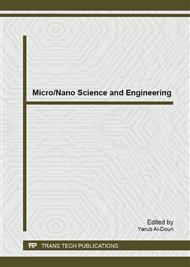[1]
Ampere A. Tseng, Kuan Chen, Chii D. Chen, and Kung J. Ma, Electron Beam Lithography in Nanoscale Fabrication: Recent Development, IEEE Transaction on Electronics Packaging Manufacturing, 2003, 26(2), pp.141-149.
DOI: 10.1109/tepm.2003.817714
Google Scholar
[2]
Rahman S.F.A., Hashim, U., Nor M.N.M., Mohamed Nuri, A.M., Shohini, M.E.A., Salleh,S., Nanowire formation using electron beam lithography, AIP Conference Proceedings, 1136 (2009) 504-508.
DOI: 10.1063/1.3160194
Google Scholar
[3]
Nuzaihan Md Nor,M., Hashim, U., Halim, N.H.A., Bajuri, S.N.M., Nanowire formation for single electron transistor using SEM based Electron Beam Lithography(EBL) technique: Positive tone vs negative tone e-beam resist, NSTI Nanotech 2006 Technical proceeding, 3, 2006, pp.266-269.
DOI: 10.4028/www.scientific.net/amr.832.419
Google Scholar
[4]
F. Demami, L. Ni, R. Rogel, A.C. Salaun, L. Pichon, Silicon nanowires based resistors as gas sensors, Sensors and Actuators B 170 (2012) 158– 162.
DOI: 10.1016/j.snb.2011.04.083
Google Scholar
[5]
Robert Juhasz, Kai Kylmanen, Augustinas and Jan Linnros, Size-reduced silicon nanowires: Fabrication and electrical characterization, Elsevier, Material Science and Engineering , pp.733-737, (2005).
DOI: 10.1016/j.msec.2005.06.036
Google Scholar
[6]
Md Nor, M.N., Hashim, U., Nazwa, T., Adam, T. Fabrication of silicon nanowires by electron beam lithography and thermal oxidation size reduction method (2014) Advanced Materials Research, 832, pp.415-418.
DOI: 10.4028/www.scientific.net/amr.832.415
Google Scholar
[7]
C-H. Lin et al, Poly-silicon nanowire field-effect transistor for ultrasensitive and label-free detection of pathogenic avian influenza DNA, Biosensor and bioelectronics 24 (2009) pp.3019-3024.
DOI: 10.1016/j.bios.2009.03.014
Google Scholar
[8]
Arpita De, Jan van Nieuwkasteele, Edwin T. Carlen and Albert van den Berg, Integrated label-free silicon nanowire sensor arrays for (bio) chemical analysist, Analyst, 2013, 138, 3221.
DOI: 10.1039/c3an36586g
Google Scholar
[9]
Hahm, J.; Lieber, C. M. Direct ultrasensitive electrical detection of DNA and DNA sequence variations using nanowire nanosensors. Nano Lett. 2004, 4, 51–54.
DOI: 10.1021/nl034853b
Google Scholar
[10]
Hou-Yu Chen, Chia-Yi Lin, Min- Cheng, Chien-Chao Huang and Cho-Hsin Chien. Fabrication of High- Sensitivity Polycrystalline Silicon Nanowire Field Effect Transistor pH Sensor using conventional CMOS techmology. Japanese Journal of Applied Physics 50, Issue 4, (2011).
DOI: 10.1143/jjap.50.04dl05
Google Scholar
[11]
Hong Xiao, Introduction to Semiconductor Manufacturing Technology. International Edition, Prentice Hall, New Jersey, (2001).
Google Scholar


